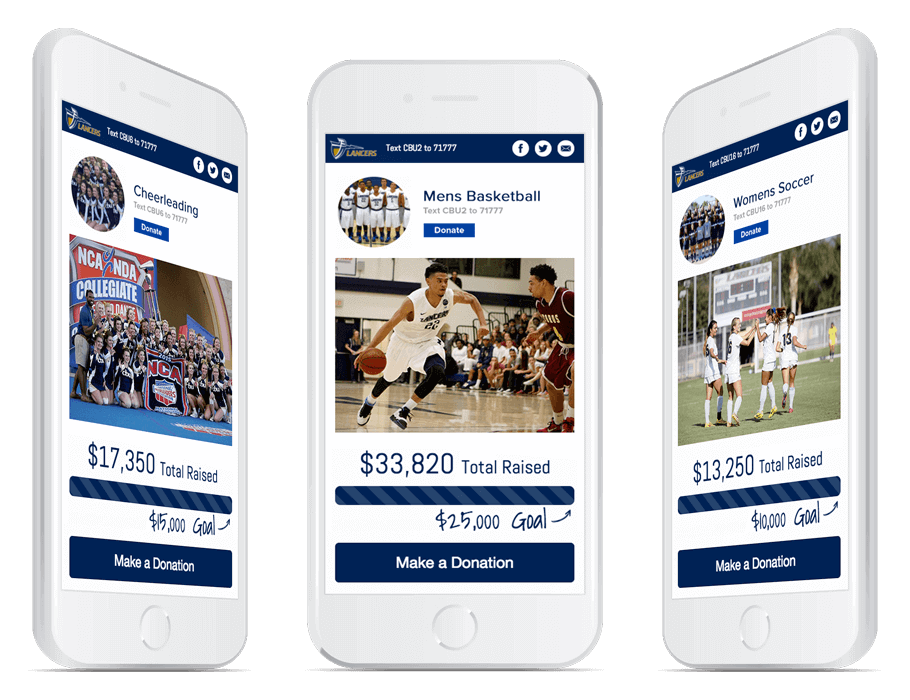Jan 9, 2021
Plan a Capital Campaign in 7 Stress-Free Steps


Capital campaigns, fundraising efforts that raise money for large-scale nonprofit projects, are an important part of supporting your organization’s continued success.
With fundraising goals totaling in the millions of dollars, capital campaigns can be an ambitious undertaking, and it’s understandable if the thought of taking one on causes some anxiety.
However, planning the strategy that drives your next capital campaign doesn’t have to be stressful. In fact, with our 7 easy-to-follow steps, you can prepare your next capital campaign with ease.
To get ready for your next capital campaign, you should:
- Start with capital campaign pre-planning
- Choose the right software for your capital campaign
- Design a giving pyramid
- Conduct a capital campaign feasibility study
- Delegate capital campaign tasks
- Create a capital campaign website
- Write your official capital campaign plan
Planning a successful capital campaign has never been easier. Let’s get started!
1. Start with capital campaign pre-planning
One reason capital campaigns have such a daunting reputation? They require detailed, meticulous planning before getting out of the gate. While your nonprofit might want to jump right in, it’s important that you lay the right foundation for your campaign before starting.
Not sure how to get started? Your capital campaign pre-planning process should include these important steps:
- Establish your campaign goals. It isn’t enough to say, “We should raise money to build a new headquarters.” Your nonprofit needs to determine concrete objectives such as how much money is needed to fund your project, your deadline for meeting your fundraising goal, and more.
- Gain board approval. Capital campaigns are huge undertakings and to be successful at them, your nonprofit needs to have full board member support. Not only do you need to win them over, but your board should also be right there with you during the pre-planning process to help iron out big-picture ideas.
- Determine campaign leadership. Your capital campaign will need a dedicated team to see the project through from start to finish. Single out motivated members of your board, department heads from your staff, and proven volunteers to be a part of this task force.
- Draft an early case for support. Ultimately, your case for support will be one of the most important aspects of your capital campaign’s success. Your case doesn’t need to be finalized now, but the pre-planning process is when your nonprofit should start defining why your campaign is worthy of donors’ support.
- Create a “vision” for a campaign. During this pre-planning phase, start imagining how you’d like to see the campaign play out as time goes on. This should be developed into a concrete fundraising timeline down the road, but for now, just worry about getting a feel for what to expect.

The bottom line: Your nonprofit shouldn’t begin the planning process without establishing a foundation upon which you will build your campaign. Take the time to think through the basics before making any plans!
2. Choose the right software for your capital campaign
Part of making your capital campaign a success is investing in the right software to support your nonprofit’s efforts, particularly during the public phase of your capital campaign. With fundraising software, you can empower your campaign by making it easier to interact with donors, collect donations, and analyze trends in your engagements.
During the capital campaign planning process, consider adopting one or more of the following nonprofit software solutions:
- CRM. Constituent relationship management (CRM) software is the bread-and-butter software solution for nonprofits. With a CRM, you can more effectively manage your donor interactions as well as keep track of prospects. During your capital campaign, a CRM can prove especially useful for overseeing major donor interactions.
- Online giving. With onling giving software, your nonprofit can seamlessly accept donations via any device with an internet connection. Be sure to choose an online giving software that helps with tasks related to donation transactions, such as automated thank-you messages and receipt generation.
- Fundraising events. If your nonprofit intends to host fundraising events to raise money for your capital campaign, investing in this type of software is a must. Fundraising events software can help you keep track of attendees, accept donations, sell tickets, as well as many other tasks related to event management.
- Crowdfunding and P2P. Crowdfunding campaigns, as well as P2P campaigns, are great ways to leverage the support of your donors to broaden the reach of your capital campaign. If you’re interested in this style of fundraising, invest in software that allows you to do things like customizing donation pages and accepting mobile donations.

The bottom line: Investing in software to amplify the impact of your fundraiser is an integral part of preparing for your capital campaign. Not only that, whatever software solution you choose will undoubtedly strengthen your fundraising efforts in future campaigns, as well.
3. Design a giving pyramid
As your nonprofit plans out your capital campaign, one of the most important things to develop is your gift range objectives. To reach your capital campaign’s goal, you’ll likely extend asks to prospects with varying levels of giving capacity.
During the quiet phase of your planning process, dedicate time to designing a gift range pyramid that outlines how you’ll reach your capital campaign goal. This pyramid should break down your objective and show you exactly how it should be achieved by outlining:
- Your gift ranges
- How many donors should give within each range
- How many prospects to whom your nonprofit should extend asks
Additionally, when developing your giving pyramid, segment specific individuals as major donor prospects for your top gift ranges.

You should reach out to more individuals to give at these higher levels than you actually need to account for those gifts. Your nonprofit is more likely to be turned down for too high an ask than a smaller one, and you can always counter by requesting they donate at a more modest level.
Bonus tip! Your giving pyramid can also come in handy after the capital campaign planning process. Consider including the diagram in your marketing materials, especially your capital campaign’s brochure. In much the same way the pyramid helps your team plan out asks for your campaign, it can help potential donors see how much money they should give to help your nonprofit get closer to your goals.
The bottom line: Without an established gift range pyramid, your nonprofit won’t be able to effectively strategize donation requests. Take the time to design your gift range pyramid so that over the course of your capital campaign there aren’t any surprises when making your asks.
4. Conduct a capital campaign feasibility study
Another important phase of your capital campaign process is conducting your feasibility study. Feasibility studies help nonprofits figure out how to structure their fundraising strategy when taking on a capital campaign.
Typically, a third party will anticipate how your nonprofit’s efforts will be received by stakeholders and donors. By interviewing these individuals, the third-party representative (usually from a fundraising consulting firm) will then take these reactions and determine whether or not your proposed capital campaign is viable.
Specifically, these interviews will provide your nonprofit the necessary context to ascertain:
- Who is suitable for campaign leadership
- Who is willing to contribute
- How the community views the nonprofit’s reputation
- Whether the campaign would be successful
The bottom line: Getting an outsider’s perspective is crucial to making your capital campaign a success. With their assessment, your nonprofit can move forward in planning your campaign with a better understanding of your strengths, weaknesses, and limitations.
5. Delegate capital campaign tasks
Just as your nonprofit depends on the hard work of many individuals, so does the success of your capital campaign. One person or department cannot take on a capital campaign alone, and it’s important for your nonprofit to clearly and efficiently delegate tasks when planning this project.
Your nonprofit can ensure that tasks are delegated effectively in a number of ways:
- Form committees. Specialized committees are a great way to delegate tasks during the capital campaign process because they allow members to focus on a singular task at hand, rather than juggle many different tasks relating to your overall goal. Consider, for instance, forming a Planning Committee and a Steering Committee.
- Select chairs. In addition to forming committees, your nonprofit should select committee chairs to lead these groups. A chair can be tasked with having the final say on a committee’s decisions, but also remain looped in with other chairs to keep an eye on the big picture of your fundraising goal.
- Rely on your board. Your board can be a great resource to lean on during capital campaigns, especially when delegating tasks. Board members can support your efforts by identifying lead donor prospects, using their connections to request donations (when appropriate), and making contributions themselves.
The bottom line: Making your capital campaign a success will require bringing your staff, supporters, and board members together. Share efforts evenly across your organization, but be sure the delegated tasks all build upon one another to bring you closer to your capital campaign’s finish line.
6. Create a capital campaign website
Creating a website as home base for your capital campaign is a must! During the planning process, your nonprofit should work with a fundraising software solution to build a website for your campaign that will provide donors with a convenient path to donation.
Your website should allow you to perform all of the following tasks:
- Explain the purpose of your campaign. Don’t expect donors to know the who, what, where, and why of your campaign. Use your website to clearly outline the details of your capital campaign and why it’s worthy of their support.
- Advertise campaign events. Be sure to publicize your campaign’s events on your website, as it will be the go-to resource for individuals interested in getting involved with your organization.
- Collect online donations. Your website should also be fully equipped to accept online donations, both via desktop and mobile devices. Provide easy to use online donation forms and make use of CTAs (calls to action) throughout the site to encourage visitors to give.

The capital campaign’s website can mirror your campaign’s brochure, and should also clearly make your case for support. Most donors will interact with this website at some point, so it’s important that your site be compelling and convenient for your donors to access.
The bottom line: Don’t hide your capital campaign away on your organization’s main website. Instead, be sure to dedicate a website to your capital campaign in order to give yourself enough room to explain why donors should contribute to your cause, as well as ease them into supporting your campaign.
7. Write your official capital campaign plan
Planning your capital campaign isn’t just a behind-the-scenes exercise to benefit a select few of your nonprofit’s leadership. After developing your plan, your nonprofit should then create an official, written capital campaign plan to be referenced by all members of your organization.
Your formal capital campaign plan should include the following information:
- The campaign’s budget. Not only should your nonprofit determine an overall budget for this campaign, but you should also create sub-budgets for each campaign committee. Make sure all of your staff and supporters know where your money is being allocated to prevent overspending in certain areas.
- A timeline of events. Establish a firm timeline of fundraising events for your campaign. These shouldn’t be limited to public events, but should also include internal deadlines, milestone markers, and other important dates to keep your organization on track.
- Your campaign’s goals. Be sure to define clear, organization-wide campaign goals. Your staff and supporters will use these to guide them in their fundraising efforts and can be referenced to the public when making your case for support.
- A communications plan. How will your nonprofit strategize communications efforts during the campaign? Before your campaign begins, affirm how you will broadcast your message to supporters, reach out to prospects, and advertise fundraising events.
- Your donor stewardship plan. Develop a concrete stewardship plan before you start your campaign; donor stewardship is an important part of any campaign planning process, but it is especially necessary during a capital campaign since your fundraising goal will require extra support from major donors this time around.
The bottom line: After putting so much work into planning your campaign, don’t neglect to share your plan with your organization as a whole. It’s important for everyone to be on the same page, so take the time to make an official plan for your staff, supporters, and board to reference.
Your next capital campaign will certainly be an ambitious undertaking, but you don’t have to stress over the planning process! With these steps as your guide, you’ll be able to develop your campaign’s plan in no time.
Related



